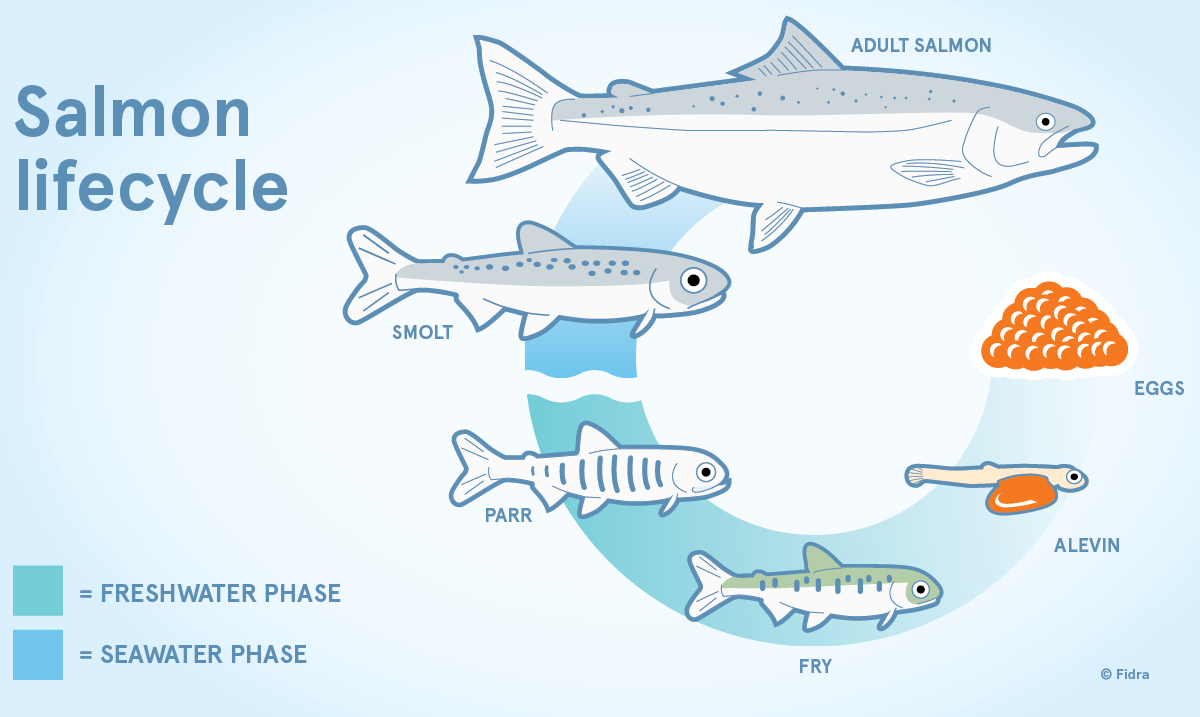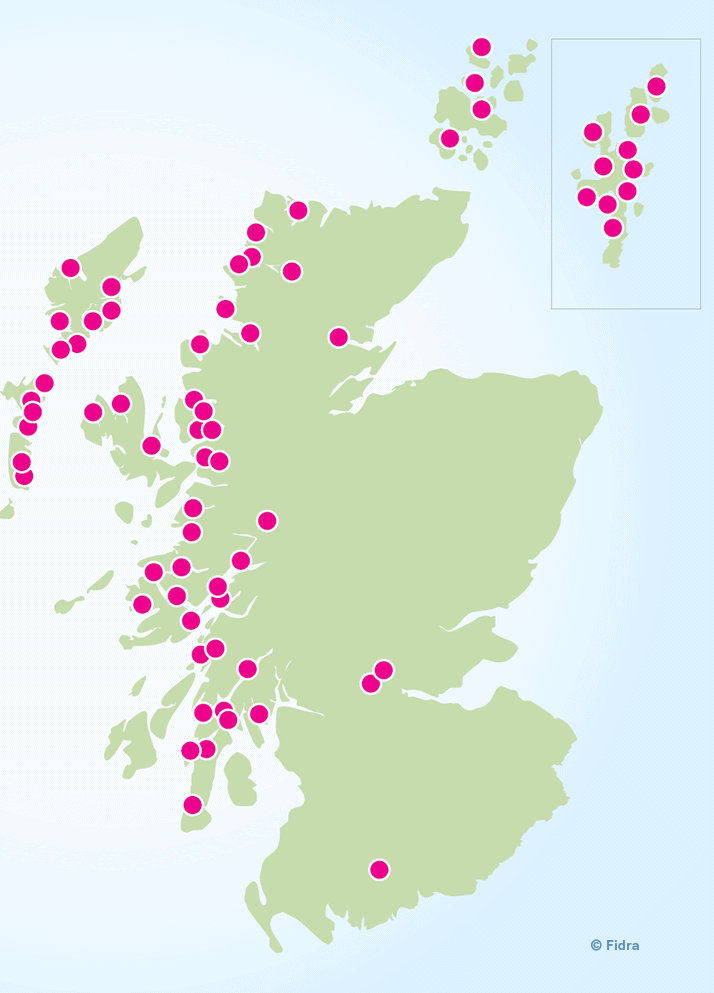Scottish Salmon Farming
In Scotland all commercial Atlantic salmon (Salmo salmar) products are from farmed stocks. The Scottish Government banned the sale of rod caught salmon in 2002, making it illegal to sell any Atlantic Salmon caught by rod and line1. Then further protective measures were put in place under the Conservation of Salmon (Scotland) Regulations 2016 to manage the killing of wild Atlantic salmon2. The Scottish salmon farming industry has grown steadily since the 1970’s and is now a major part of Scottish aquaculture, despite environmental and sustainability concerns. At present the industry is worth of over £1.8bn annually and provides more than 8,000 jobs3. Scotland is the largest producer of farmed Atlantic salmon in the EU and the third largest in in the world after Norway and Chile4. The industry is expected to more than double its production by 20305.
In 2023 the Scottish Government published a ‘Vision for sustainable aquaculture’ , following two Scottish Government inquiries and a review of existing regulations by Prof. Griggs. This Vison sets out plans for the future of aquaculture in Scotland up to 2045 and aims to accommodate economic, societal and environmental dimensions of the aquaculture sector.
Salmon Life Cycle
Salmon are anadromous, meaning that they have freshwater and saltwater stages within their life cycle. They are born in freshwater, migrating to the ocean as young adults and returning to freshwater to reproduce. The juvenile freshwater stage of Atlantic salmon (Salmo salmar) takes 24-36 months in the wild, and 6-12 months in farms, developing from egg through the alevin, fry and parr stages to the smolt stage which can then move to saltwater.

Smolts are initially 12-15 cm (5-6 inches) long, 50-80 g and distinguished by bright silvery colouring with scales that easily rub off.At around 100g smolt are moved from freshwater to sea water, where they develop into the adult salmon stage. On farms it takes 14-24 months to reach a full-size adult. In the wild the salmon return to their natal river after 24-36 months to spawn.
There has been a trend to keep smolt size (post-smolt) before transferring to seawater, from between 100 to 1000 g.
The average size of an Atlantic salmon in the wild is 71-76 cm (28-30 inches) long and 3.6-5.4 kg (8-12 pounds) after two years at sea. Adults can grow to be 13.6 kg (30 pounds). Harvest size in farms is about 4.5-5.5 kg.
Fish Farm Siting in Scotland
Atlantic salmon culture began in the 19th century in the UK in freshwater as a means of stocking waters with juvenile (“parr”) stages to enhance wild populations for anglers. Open sea pens or cages were first used in the 1960s in Norway to raise fish to marketable size, and the success led to development of salmon farming in Scotland, and subsequently Ireland, the Faroes Islands, Canada, the North Eastern seaboard of the USA, Chile and Australia (Tasmania), with some minor production in New Zealand, France and Spain.
In Scotland fish farms are based on the west and north-west coasts, due to a presumption in Scottish Planning Policy against marine finfish farm developments on the north and east coasts to safeguard migratory fish species.
Scottish strains of salmon tend to mature early, reducing the value of the fish as they reach market size, so Norwegian strains were introduced to reduce the problem. Generations of cross breeding have produced hybrid strains which are now used in most production areas. Scotland hatcheries now import fertilised eggs to produce larval and juvenile fish. Once hatched, these are grown on in tanks either using freshwater flow-through or land-based recirculating systems RAS technology allows for recycling most of the fresh water used for our land based farming. Recirculating Aquaculture Systems recycles 90 – 97% of the fresh water used in land based farming operations (RAS), or subsequently in lake cage systems. At the final juvenile (“smolt”) stage they are transferred to on-growing systems, usually coastal open net pen farms, to reach harvest size.

Salmon Farm Structures
Atlantic salmon eggs are obtained from broodstock fish, bred on selected characteristics such as growth, disease resistance, maturation rate or colour. In Scotland, hatcheries use imported fertilised eggs to produce larval and juvenile fish. Once hatched, fry can be grown on in tanks either using freshwater flow-through or land-based RAS, or subsequently in lake cage systems through parr stages to smolt. Smolt are transferred to on-growing systems, usually open net pen farms, to reach harvest size. The majority of smolt are produced by salmon farming companies for their own use, and usually released into seawater twice a year.
The three main production systems are shown below. Recirculating systems technology can be used for either the freshwater or saltwater stage of salmon aquaculture.

Seasites are selected on their suitability with regard to water temperature, salinity, flow and exchange rates, proximity to other farms and/or wild fisheries and in compliance with local licensing regulations. Atlantic salmon grow best where water temperature is in the range of 6-16⁰C. and salinities close to oceanic levels (33-34 ‰). Water flows need to be sufficient to eliminate waste and supply well oxygenated water (approximately 8ppm). Maximum stocking densities of 20 kg/m3 are usual.
On-growing in seasites takes up to 2 years, with harvesting of fish from 2 kg upwards. Seasites normally contain a single generation of fish. Harvesting takes place throughout the year, although most takes place in the last quarter of the year as this is the period of best growth. After a site is harvested, good practice is to fallow the location for a period of 6 weeks or more before introducing a new generation of fish.
FAQs
Should I be buying Scottish salmon?
Our retailer table will give you information about how UK retailers are sourcing their salmon and the standards they require, helping you to make an informed decision.
Is any Scottish salmon being farmed responsibly?
Our certification guide will help to explain the standards used in the Scottish salmon industry. Guides produced by the Marine Conservation Society (MCS) UK[1] and Monteray Bay Aquarium’s Seafood Watch[2] are also widely used to gauge whether Scottish salmon is responsibly produced.
Is salmon good for you?
All foods should be eaten in moderation and salmon is no exception.
See the Human Health section on our Impacts page.
Why is salmon so pink?
The colour comes from pigments in the salmon’s food called carotenoids, a group of pigments naturally occurring in plants and animals. Nature-identical synthesized pigments are used in salmon feeds.
See the Human Health section on our Impacts page.
How does salmon farming impact the environment?
Salmon aquaculture has a number of environmental impacts.
See the Environmental Impacts page for more information
Is all Scottish salmon farmed?
Yes, since 2002 all Scottish salmon is farm produced.
What is the Scottish government doing to improve the Scottish salmon aquaculture industry?
Following Professor Griggs Review of the Aquaculture Regulatory Process in Scotland, the Scottish Government published its ‘Vision for Sustainable Aquaculture’ in 2023. The Vision sets out plans for the future of aquaculture in Scotland up to 2045 and aims to accommodate economic, societal and environmental dimensions of the aquaculture sector.
The Scottish Environmental Protection Agency (SEPA) has taken steps to address the impacts of sea lice transferring from farms to migrating juvenile wild salmon through development of a spatially based sea lice risk assessment framework. following public consultation, this framework will be implemented in 2024. SEPA also aim to implement a new online information system (dashboard) to allow access to up to date information on salmon farms, on a site by site basis.
Who regulates salmon aquaculture in Scotland?
Salmon aquaculture is a devolved issue, meaning that legislation and regulation of the industry is under the remit of the Scottish Government. The Scottish Environmental Protection Agency (SEPA) is charged with enforcement of environmental regulation and legislation, which is also devolved.
What are the alternatives to expanded polystyrene (EPS) fish boxes?
EPS boxes are used extensively for transportation of seafood products, with the majority disposed of after one use, making them an industrial scale single-use-plastic. However a number of alternatives are available, and in 2021 Fidra commissioned TAUW to produce a report investigating available alternatives to EPS fish boxes. The report is available to download here.
How many salmon farms are in Scotland?
As of 2022 there was a total of 210 active farm sites in Scotland.
How much salmon does Scotland produce each year?
In 2022 Scotland produced 169,194 tonnes of salmon
References
[1] The Conservation of Salmon (Prohibition of Sale) (Scotland) Regulations 2002, (2002) (testimony of Scottish Government). Available at https://www.legislation.gov.uk/ssi/2002/418/introduction/made
[2] The Conservation of Salmon (Scotland) Regulations 2016, (2016) (testimony of Scottish Government). Available at https://www.legislation.gov.uk/ssi/2016/115/regulation/3/made
[3] Marine Scotland. (2020). Scottish Fish Farm Production Survey 2019. Available at https://www.gov.scot/publications/scottish-fish-farm-production-survey-2019/pages/5/
[4] Kenyon, W., & Davies, D. (2018). SPICe Briefing – Salmon Farming in Scotland. https://sp-bpr-en-prod-cdnep.azureedge.net/published/2018/2/13/Salmon-Farming-in-Scotland/SB%2018-12%20rev.pdf
[5] Scottish Goverment. (2020). Supporting the economic, social and environmental sustainability of the UK’s marine sectors. Available at https://www.gov.scot/publications/supporting-economic-social-environmental-sustainability-uks-marine-sectors/pages/3/

